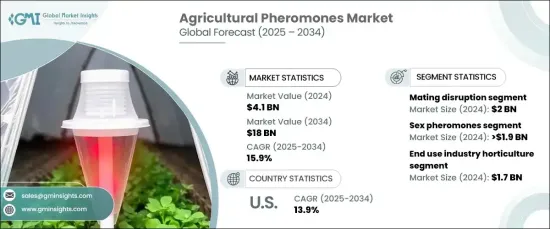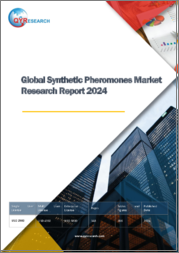
|
시장보고서
상품코드
1665246
세계의 농업용 페로몬 시장 : 기회, 성장 촉진요인, 산업 동향 분석, 예측(2025-2034년)Agricultural Pheromones Market Opportunity, Growth Drivers, Industry Trend Analysis, and Forecast 2025 - 2034 |
||||||
세계의 농업용 페로몬 시장은 2024년 41억 달러에 달했고, 2025-2034년까지 CAGR 15.9%로 현저한 성장을 이룰 것으로 예측되고 있습니다.
이 두드러진 성장은 지속 가능한 해충 제거 방법으로의 변화 증가에 의해 초래됩니다. 농업용 페로몬은 특정 해충을 유인하거나 기피하는 데 사용되는 천연 화학 신호이며 기존의 화학 농약을 대체하는 환경 친화적 인 대안을 설명합니다. 이 페로몬은 특히 과일, 야채, 곡물 재배에서 교배 교란 기술, 해충 모니터링, 곤충 포획에 중요한 역할을합니다.

2024년 성 페로몬 부문은 19억 달러를 차지했으며 2034년까지 16%의 연평균 복합 성장률(CAGR)로 성장할 것으로 예상됩니다. 성 페로몬은 해충을 끌어들이거나 혼란시키는 화학물질을 방출하여 대상이 되는 해충의 교미 행동을 방해하기 때문에 해충 방제에 필수적입니다. 이 때문에 농작물에 상당한 손해를 끼치는 나방, 딱정벌레, 양파 등의 해충을 치료하는 데 매우 효과적입니다. 성 페로몬의 주요 용도는 교미 방해로, 합성 페로몬을 대량으로 방출하여 해충을 혼란시키고, 교미의 성공을 저지해 해충의 개체수의 감소로 연결합니다.
| 시장 범위 | |
|---|---|
| 시작 연도 | 2024년 |
| 예측 연도 | 2025-2034년 |
| 시작 금액 | 41억 달러 |
| 예측 금액 | 180억 달러 |
| CAGR | 15.9% |
교배 교란 기술은 농업용 페로몬 시장의 주요 부문에 부상했으며 2024년 시장 규모는 200만 달러였습니다. 2025-2034년까지 CAGR 16.1%로 확대될 것으로 예측되고 있습니다. 교미 방해는 해충의 교미 활동을 방해하기 위해 합성 페로몬을 방출하는 것으로, 지속 가능한 해충 방제에 중요한 역할을 합니다. 이 접근법은 환경이나 비표적 종에 해를 끼치지 않고 해충의 개체수를 줄이는데 매우 효과적입니다. 교미 방해는 과일, 채소, 곡물과 같은 농작물을 보호하는 데 특히 효과적이며, 농약 사용량을 줄이고 환경에 미치는 영향을 최소화하고 작물 수율을 향상시키는 등 많은 이점이 있습니다.
미국의 농업용 페로몬 시장은 2024년 9억 9,090만 달러로 평가되었으며, CAGR 13.9%의 견조한 성장이 예상됩니다. 세계 시장의 주요 지역 중 하나인 미국에서는 지속 가능한 농업 관행과 혁신적인 해충 관리 솔루션이 널리 채택되었습니다. 이 성장은 농약 사용을 줄이는 규제 압력이 증가하고 유기농 농업에 대한 선호도가 높아짐에 따라 더욱 향상되었습니다. 또한 IoT 기반 모니터링 시스템과 무인 항공기와 같은 정밀 농업 기술에 대한 수요가 증가함에 따라 이 지역의 해충 제거 효율과 효과 향상을 촉진하고 있습니다.
목차
제1장 조사 방법과 조사 범위
- 시장 범위와 정의
- 기본 추정과 계산
- 예측 계산
- 데이터 소스
- 1차 데이터
- 2차 자료
- 유료 정보원
- 공적 정보원
제2장 주요 요약
제3장 산업 인사이트
- 생태계 분석
- 밸류체인에 영향을 주는 요인
- 이익률 분석
- 변혁
- 미래의 전망
- 제조업체
- 유통업체
- 공급자의 상황
- 이익률 분석
- 주요 뉴스
- 규제 상황
- 영향요인
- 성장 촉진요인
- 지속 가능한 농업에 대한 수요 증가
- 무농약 농산물에 대한 소비자의 기호의 고조
- 페로몬 제제 기술의 진보
- 산업의 잠재적 리스크 및 과제
- 페로몬 기반 제품의 높은 생산 비용
- 성장 촉진요인
- 성장 가능성 분석
- Porter's Five Forces 분석
- PESTEL 분석
제4장 경쟁 구도
- 소개
- 기업 점유율 분석
- 경쟁 포지셔닝 매트릭스
- 전략 전망 매트릭스
제5장 시장 추정·예측 : 유형별, 2021-2034년
- 주요 동향
- 성페로몬
- 집합 페로몬
- 경보 페로몬
- 트레일 페로몬
- 기타
제6장 시장 추정·예측 : 작용기전별, 2021-2034년
- 주요 동향
- 교배 교란 기술
- 대량 포획
- 유인 및 살상
- 모니터링 및 검출
- 기타
제7장 시장 추정·예측 : 최종 용도별, 2021-2034년
- 주요 동향
- 원예작물
- 밭작
- 기타
제8장 시장 추정·예측 : 지역별, 2021-2034년
- 주요 동향
- 북미
- 미국
- 캐나다
- 유럽
- 영국
- 독일
- 프랑스
- 이탈리아
- 스페인
- 러시아
- 아시아태평양
- 중국
- 인도
- 일본
- 한국
- 호주
- 라틴아메리카
- 브라질
- 멕시코
- 중동 및 아프리카
- 남아프리카
- 사우디아라비아
- 아랍에미리트(UAE)
제9장 기업 프로파일
- Suterra
- BASF SE
- BedoukianBio(Bedoukian Research의 일부)
- Biobest Group NV
- Corteva Agriscience
- FMC Corporation
- ISCA Technologies
- Pherobank
- Russell IPM
- Scyll'agro
- Shin-Etsu Chemical
- Trece
The Global Agricultural Pheromones Market reached USD 4.1 billion in 2024 and is projected to experience significant growth, with a CAGR of 15.9% from 2025 to 2034. This remarkable growth is driven by an increasing shift towards sustainable pest control methods. Agricultural pheromones, which are natural chemical signals used to attract or repel specific pests, provide an eco-friendly alternative to traditional chemical pesticides. These pheromones play a crucial role in mating disruption, pest monitoring, and insect trapping, particularly in the cultivation of fruits, vegetables, and grains.

In 2024, the sex pheromones segment accounted for USD 1.9 billion, with expectations for it to grow at a 16% CAGR through 2034. Sex pheromones are essential in pest control as they disrupt the mating behaviors of targeted pests by emitting chemicals that attract or confuse them. This makes them highly effective in managing pests such as moths, beetles, and fruit flies, which can cause significant damage to crops. The primary application of sex pheromones is mating disruption, wherein synthetic pheromones are released in large volumes to confuse pests, preventing successful mating and leading to a reduction in pest populations.
| Market Scope | |
|---|---|
| Start Year | 2024 |
| Forecast Year | 2025-2034 |
| Start Value | $4.1 Billion |
| Forecast Value | $18 Billion |
| CAGR | 15.9% |
The mating disruption technique emerged as the leading segment in the agricultural pheromones market, valued at USD 2 million in 2024. It is projected to expand at a CAGR of 16.1% between 2025 and 2034. Mating disruption plays a vital role in sustainable pest control practices, as it involves releasing synthetic pheromones to interfere with the mating activities of pests. This approach is highly effective in decreasing pest populations without causing harm to the environment or non-target species. Mating disruption is particularly beneficial for protecting crops like fruits, vegetables, and grains, offering numerous advantages such as reduced pesticide use, minimal environmental impact, and improved crop yields.
The U.S. agricultural pheromones market, valued at USD 990.9 million in 2024, is expected to grow at a robust CAGR of 13.9%. As one of the leading regions in the global market, the U.S. has seen widespread adoption of sustainable agricultural practices and innovative pest management solutions. This growth is further bolstered by increasing regulatory pressures to reduce pesticide use and the growing preference for organic farming. Additionally, the rising demand for precision agriculture technologies, such as IoT-based monitoring systems and drones, is driving enhanced pest control efficiency and effectiveness in the region.
Table of Contents
Chapter 1 Methodology & Scope
- 1.1 Market scope & definitions
- 1.2 Base estimates & calculations
- 1.3 Forecast calculations
- 1.4 Data sources
- 1.4.1 Primary
- 1.4.2 Secondary
- 1.4.2.1 Paid sources
- 1.4.2.2 Public sources
Chapter 2 Executive Summary
- 2.1 Industry synopsis, 2021-2034
Chapter 3 Industry Insights
- 3.1 Industry ecosystem analysis
- 3.1.1 Factor affecting the value chain
- 3.1.2 Profit margin analysis
- 3.1.3 Disruptions
- 3.1.4 Future outlook
- 3.1.5 Manufacturers
- 3.1.6 Distributors
- 3.2 Supplier landscape
- 3.3 Profit margin analysis
- 3.4 Key news & initiatives
- 3.5 Regulatory landscape
- 3.6 Impact forces
- 3.6.1 Growth drivers
- 3.6.1.1 Increasing demand for sustainable agriculture practices
- 3.6.1.2 Rising consumer preference for pesticide-free produce
- 3.6.1.3 Advancements in pheromone formulation technologies
- 3.6.2 Industry pitfalls & challenges
- 3.6.2.1 High production costs of pheromone-based products
- 3.6.1 Growth drivers
- 3.7 Growth potential analysis
- 3.8 Porter’s analysis
- 3.9 PESTEL analysis
Chapter 4 Competitive Landscape, 2024
- 4.1 Introduction
- 4.2 Company market share analysis
- 4.3 Competitive positioning matrix
- 4.4 Strategic outlook matrix
Chapter 5 Market Estimates & Forecast, By Type, 2021-2034 (USD Billion) (Kilo Tons)
- 5.1 Key trends
- 5.2 Sex pheromones
- 5.3 Aggregation pheromones
- 5.4 Alarm pheromones
- 5.5 Trail pheromones
- 5.6 Others
Chapter 6 Market Estimates & Forecast, By Mode of action, 2021-2034 (USD Billion) (Kilo Tons)
- 6.1 Key trends
- 6.2 Mating disruption
- 6.3 Mass trapping
- 6.4 Attract-and-kill
- 6.5 Monitoring and detection
- 6.6 Others
Chapter 7 Market Estimates & Forecast, By End Use, 2021-2034 (USD Billion) (Kilo Tons)
- 7.1 Key trends
- 7.2 Horticulture
- 7.3 Field crops
- 7.4 Others
Chapter 8 Market Estimates & Forecast, By Region, 2021-2034 (USD Billion) (Kilo Tons)
- 8.1 Key trends
- 8.2 North America
- 8.2.1 U.S.
- 8.2.2 Canada
- 8.3 Europe
- 8.3.1 UK
- 8.3.2 Germany
- 8.3.3 France
- 8.3.4 Italy
- 8.3.5 Spain
- 8.3.6 Russia
- 8.4 Asia Pacific
- 8.4.1 China
- 8.4.2 India
- 8.4.3 Japan
- 8.4.4 South Korea
- 8.4.5 Australia
- 8.5 Latin America
- 8.5.1 Brazil
- 8.5.2 Mexico
- 8.6 MEA
- 8.6.1 South Africa
- 8.6.2 Saudi Arabia
- 8.6.3 UAE
Chapter 9 Company Profiles
- 9.1 Suterra
- 9.2 BASF SE
- 9.3 BedoukianBio (part of Bedoukian Research)
- 9.4 Biobest Group NV
- 9.5 Corteva Agriscience
- 9.6 FMC Corporation
- 9.7 ISCA Technologies
- 9.8 Pherobank
- 9.9 Russell IPM
- 9.10 Scyll'agro
- 9.11 Shin-Etsu Chemical
- 9.12 Trece



















